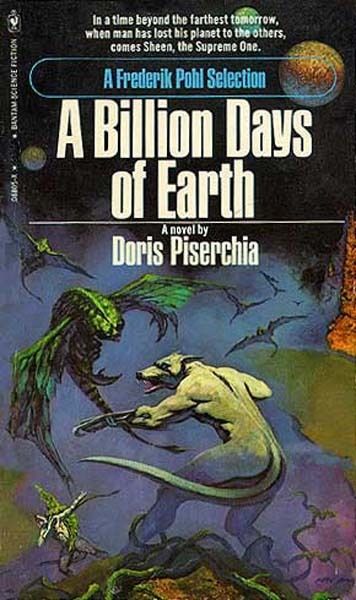Leave Behind Your Heart
A Billion Days of Earth
By Doris Piserchia

22 Nov, 2020
Doris Piserchia’s 1976 A Billion Days of Earth is a standalone SF novel.
A billion days from now — which translates to some three million years — humanity has become a race of gods. Evolution (as well as genetic tinkering) has resulted in a world filled with super-capable humans and new non-human species … many of which are as smart as humans of our time, if not as smart as the godlike humans. These new species can also be as foolish as humans of our time (which, as we know to our sorrow, can be foolish indeed).
Into this world comes a new predator.
Sheen emerges from the ground in the Valley of Death. Unlike most thinking entities, it seems to be largely mineral in nature. Nevertheless, the flowing metal being hungers. What it wants: other beings’ egos. It deploys seductive words and images to entice its victims into an inescapable dream world.
The great city of Ofsar, near the Valley of Death, is home to a promising civilization of intelligent rats. They don’t have human-like hands, but they have developed prostheses that do the job. These rats are so like the humans of old that the Gods have given some of the rats human names, names of famous figures from human history.
Sheen has eaten every other ego in the Valley of Death. The rat-men are next on the menu. There seems to be little that they can do. Calling on the Gods for help is right out; attracting the attention of the Gods rarely works out well.
But “little” is better than “nothing at all,” as Sheen will discover.
~oOo~
Because this was written in a backward era, “man” is used to reference sapients of all genders. There are women in this setting, not that they really get to do much. The rat folk seem to have adopted human sexism, among other customs.
The novelty of the situation — an Earth with multiple intelligent species — is less than it would be if the author hadn’t decided to have the rats recapitulate human history. Rat-men are more or less interchangeable with humans.
While there’s some intriguing worldbuilding in the background, it plays a surprisingly small role in the foreground plot. The plot itself meanders a bit pointlessly (surprisingly so for a novel that is only a couple of hundred pages long). There’s room for plot, but none for developing the book’s characters, who are cardboard at best.
As I read, I found myself hoping that the author would do more with an interesting initial premise. It was frustrating that she didn’t. Ah, well.
A Billion Days of Earthis available here (Amazon US), here (Amazon Canada), here (Amazon UK), here (Barnes & Noble), here (Book Depository), and here (Chapters-Indigo).
